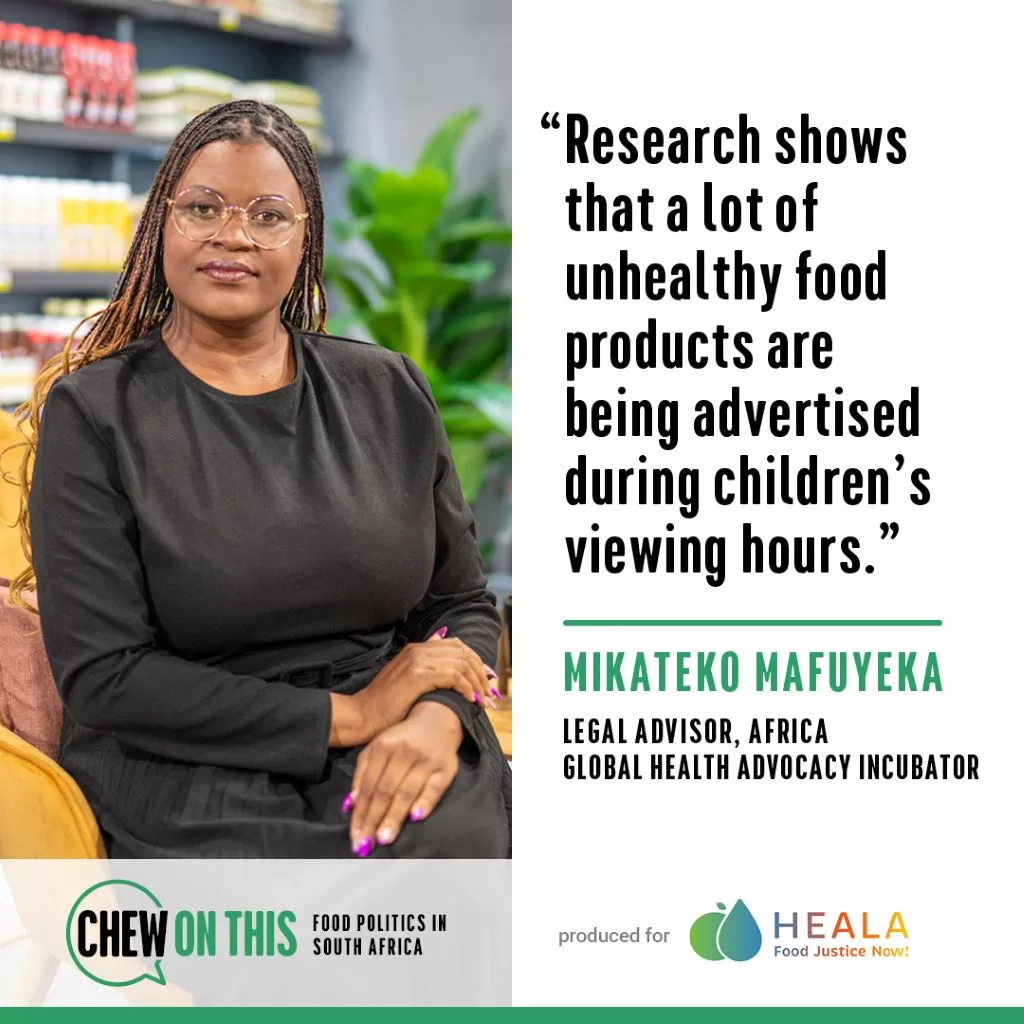How is Big Food Stalking Our Children?
Third episode of web series, Chew on This, looks into aggressive food marketing targeting children and calls on viewers to sign petition
Johannesburg, 21 August24: “My name is Vuyiseka Mangele and I’m the mother of Mihlayonke. At just five years old, my daughter now prefers Coco Pops and similar sugary cereals, largely influenced by the packaging and ads she sees. Despite my efforts to keep her diet healthy, avoiding sugar-laden foods and focusing on whole grains, she’s now attracted more to the characters on the box than the food itself. It’s worrying because she used to eat healthier meals, but now, even something as simple as not having tomato sauce with her fries or chicken nuggets can cause a fuss. Exposure to other kids and relentless marketing has shifted her tastes in ways that are hard to reverse.”
Vuyiseka’s story is just one example of how aggressive food marketing targets children. That’s the topic of the Healthy Living Alliance’s (HEALA) third episode of its thought-provoking web series, “Chew on This.”
Titled “How is Big Food Stalking Our Children?” episode three brings together a panel of experts to explore the pervasive and often hidden tactics used by the food industry to market ultra-processed products to children – practices that contribute to the growing epidemic of childhood obesity in South Africa.
The World Health Organisation (WHO) has identified unhealthy food marketing as a significant risk factor for childhood obesity. In South Africa, the situation is dire, with childhood obesity rates having nearly doubled in less than a decade. Current stats indicate that more than 13% of South African children between the ages of 6 – 14 years are considered obese. This alarming trend calls for immediate action to protect the health and future of the nation’s children.
Dr Petronell Kruger, representing HEALA, sheds light on the manipulative marketing strategies employed by major food companies. She cites examples such as the use of popular sports figures and characters from the Barbie movie to promote sugary drinks and snacks to children.
“These marketing practices are not just influencing children’s choices today – they are shaping their eating habits for life,” says Kruger. “Kids are growing up believing that consuming these unhealthy products is normal, which has lifelong consequences for their health.”
Dual burden of malnutrition and obesity
In episode three, David Harrison from NGO, DG Murray Trust, discusses the stark inequalities in South Africa’s food landscape. “We live in a country of extremes. On one hand, some children suffer from severe malnutrition, with about 1,000 children dying annually in hospitals from acute malnutrition. On the other hand, we see a rising number of children who are both stunted and overweight due to diets that are high in starch but low in essential nutrients. This is a direct result of the cheap, unhealthy foods that are readily available in our communities,” says Harrison.
Legal and ethical implications of child-targeted marketing
Part of the panel, Lori Lake, a communication and education specialist at the Children’s Institute (CI), University of Cape Town and a child rights legal advisory, highlights the ethical concerns surrounding child-targeted marketing. “Children in South Africa are particularly vulnerable to food marketing that exploits their developmental stages. They are bombarded with advertisements for ultra-processed foods products high in sugar, salt, and saturated fat, which are marketed in ways that appeal directly to their senses and emotions. Tie-ins with cartoon characters are designed to capture children’s imaginations and aspirations in very powerful way. But these ads fail to mention how harmful these foods are. By not telling the truth, we’re violating children’s right to information and to adequate nutrition and health,” Lake says.
Lake further discusses the regulatory gaps that allow these practices to persist. “Although there are voluntary codes within the advertising industry, they are not being adequately enforced. We need stronger regulations to protect children from these aggressive marketing practices.”
New regulatory measures on the horizon
Kruger notes that the South African Department of Health has published regulations aimed at curbing the marketing of unhealthy food products to children. “Regulation R3337 would be a crucial step forward. It requires that any food product with a warning label due to unhealthy ingredients cannot be marketed to children. This includes prohibiting the use of mascots, cartoon characters, or celebrities that appeal to children. These regulations align with WHO guidelines and are essential for protecting our children’s health,” says Kruger.
A call to action
HEALA calls on the South African government to prioritise the health and wellbeing of our children by fully implementing Regulation R3337 as critical tool in the fight against childhood obesity.
“The WHO unequivocally recommends regulating child-directed food marketing as a key strategy in preventing childhood obesity. By implementing these regulations, we can help reduce the prevalence of childhood obesity and alleviate the burden it places on our healthcare system,” says Kruger.
HEALA encourages the public to support the petition urging the government to expedite the implementation of Regulation R3337. Sign the petition here.



























